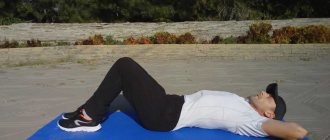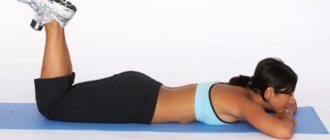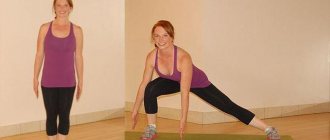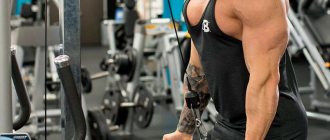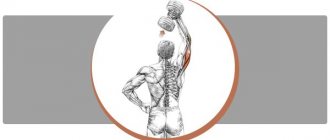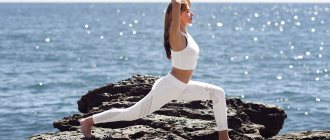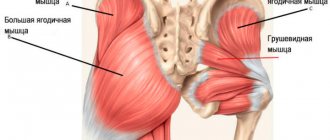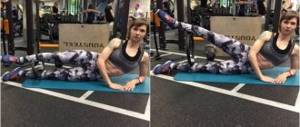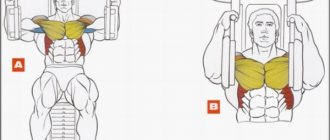Training your hips is an exclusively female activity. This is what most visitors to the hall will exclaim. Now let's try to remember the Men's classic or Olympia champion form. Apart from the protruding bellies, all other groups are designed perfectly. And all because they do not disdain such things as hip extension.
Standing hip extension[edit | edit code]
Hip extensions are classified as isolation exercises because they only move the hip joints. However, it involves not only the gluteus maximus muscle, but also the hamstrings and lower back muscles.
Execution[edit | edit code]
Performing the hip extension exercise:
Stand straight, bring your legs together, take one leg back and lift it as high as possible using your gluteal muscles. Hold this pose for a second, squeezing your gluteal muscles as hard as possible. Return to starting position and repeat. After completing the approach for one leg, repeat the exercise for the other without pausing. To increase your range of motion, you can move your leg forward so that your thigh is almost parallel to the floor. Then straighten your leg, moving it back.
Advantages
- The easiest exercise that directly engages the gluteal muscles.
- Can be done at home without sports equipment.
Flaw
- Once you have experience with strength training, you may want to move on to more effective leg exercises, such as squats or deadlifts.
By rounding your lower back, you can better feel how your gluteal muscles work. But this may put your spine at risk of injury.
Recommendations[edit | edit code]
Hip extension is limited by the degree of elasticity of the iliofemoral ligament
- Use your free hand to touch the part of the buttock you are working on. This will strengthen the connection between the brain and muscles, and will also allow you to better feel the working muscles, which makes the exercise more effective.
- You will be able to move your leg back and lift it as much as the elasticity of the iliofemoral ligament allows. Having reached the natural limit of movement, you can only lift your leg higher if you bend. But then the leg will begin to move to the side, and not back. In this case, muscle tension moves from the gluteus maximus muscle to the gluteus medius muscle.
- To really hit your gluteus maximus, don't move your leg too far to the side. A little sideways movement is acceptable, but try to limit it.
Standing option using a cable machine
Standing options[edit | edit code]
- If you enjoy doing this exercise while standing, then unless you are at the lowest level of fitness, we recommend that you do not waste time doing it without additional load. You can use a resistance band, calf weights, or a cable machine (a cable attached to a cuff worn around the ankle) to increase the resistance.
Standing option using an elastic band
Free weights or machines?[edit | edit code]
All hip extension variations are approximately the same. Their main difference is the level of load that is applied to the gluteal muscles and the range of motion. Calf weights, resistance bands and machines increase the load and difficulty of the exercise, thereby increasing its effectiveness in building muscle mass.
- Some glute trainers also work the area behind the knee or the Achilles tendon.
Standing option using a simulator
When, to whom, why?
Perhaps it’s worth starting with the fact that hip extension is an isolated single-joint exercise. And that means it:
- not suitable for developing muscle mass;
- does not help improve strength performance;
- performed after basic exercises (Romanian deadlift);
- not performed by male athletes in the first year of training;
- has a relatively simple range of motion and technique;
- develops muscle relief.
It is precisely because of these qualities that women especially love him, because using hip extensions, whether in simulators or in a crossover, they dry out and tighten exclusively the target muscle group of the leg, which allows them to get an ideal figure. Does it have any contraindications? If you do not have problems with joints or acute necrosis of bone tissue, then you can safely perform hip extensions. This exercise does not place stress on the spine, abdominal muscles or other target groups that require insurance.
When and who should do hip extensions in the machine. When – after fully mastering the circular basic program (15-30 workouts). During this time, the body adapts to the load, all muscle groups become toned, and the necessary amount of glycogen is stored for exercise. For anyone who wants to tighten the back of their legs. For women, the priority is to work with light weights in exercise machines. For men - hard work, after basic lifts!
Lying options[edit | edit code]
By performing exercises while lying on the floor, you increase the load on your muscles and decrease your range of motion.
- Lie on your stomach and support your body weight on your forearms. Bend your back slightly at the lower back.
- You can also do the Superman variation. Starting position: Lying on your stomach, straighten your arms and legs, then lift them at the same time. This variation also works the lower back muscles and the muscles at the back of the shoulders.
Lying hip extension and Superman
Programs
The hip extension exercise, regardless of its purpose, is included in most programs for women. Many men often exclude him from their programs, but in vain!
| Program | Number of repetitions | For what |
| Split (leg day) | 3*12 in the simulator. After the basic ones. | Maximizing the load on the back surface of the problem (here is a selection of exercises) |
| Circular (second cycle) | 5*20. Performed solo (in crossover) | To pre-exhaust the hamstrings before classic rows. |
| Home | 5*max – free weights | Keeping the target group in good shape |
| Crossfit | 5*20. Performed solo (in crossover) | Improves functional strength, helps with burpee exercises |
Kneeling options[edit | edit code]
By performing the exercise in a kneeling position, you increase the load and range of motion.
- As you bend your leg, the exercise becomes easier. When you straighten your leg, it becomes heavier. When performing the exercise in a kneeling position, you should bend your leg at an angle of 90 degrees so that it can be brought under your body and thereby increase the range of motion. The leg straightens immediately after you move it out from under the body. At this moment the knee joint is involved.
- Using an elastic band, calf weights, or cable machine, you can increase the load on your gluteal muscles.
- To increase the load, get on all fours and simultaneously lift your opposite arm and leg (for example, your right leg and left arm).
- Instead of standing on the floor, you can place your support knee on a bench to increase the range of motion and therefore the difficulty of the exercise.
- Variation on the knee with straight leg
- Knee version with bent leg and elastic band
- Variation on the knee with raised opposite legs and arms
- Option on a knee on a bench; the leg at the knee straightens towards the end of the movement
Thigh scarecrow
Too often we have to explain to patients that their pain, dysfunction, or poor performance in whatever movement they perform is caused by the great hip bugbear—tight hip flexors. The origin of this idea is unknown, but may have originated with the theory of the lower cross syndrome. She states that when the hip flexors and psoas muscles are tight and the gluteal and abdominal muscles are relaxed, the pelvis tilts forward, which leads to dysfunction. In fact, this theory perceives the body as a puppet, in which the position of the pelvis depends on which strings we pull or which muscles we strain.
Read also[edit | edit code]
- Training program for beginners
- Training program for professionals
- Exercises for the buttocks and legs (for women)
- Sports nutrition
- How to create a training program
- The best training programs for mass
- Leg muscle training
- How to pump up leg muscles
- Pumping the gluteal muscles
- How to pump up your calf muscles
- How to pump up a girl's legs
- Female legs and quadriceps
- Zhanna Rotar: exercises for legs
Silence of the gluteal muscles
Gregory Lechman, an assistant professor at the Canadian Memorial College of Chiropractic and a practitioner, published an article on his blog addressing the popular belief that the glutes are universally weak. Lechman observes that between 67 and 74% of his patients complain that their glutes are tight (inhibited). and do not work properly.
The situation resembles an epidemic. All over the world, buttocks are out of touch! Horror. Source: https://zen.yandex.ru/media/id/5d63d39a97b5d400ad6adc17/5dad50b8ddfef600af470d7b
Final Thoughts
- According to Lehman, the diagnosis of shortened hip flexors is overused. The Thomas test may give false positive results. Lehman himself often tests patients by simply placing them on a couch and stretching their leg into extension. Loss of movement is extremely rare.
- Lehman doesn't think sitting for eight hours will shorten the hip flexors.
- The feeling of hip flexor tightness can be subjective.
- Stiffness in movement does not necessarily have mechanical causes. We also have a nervous system, and restriction of movement may be associated with a perceived threat or defensive behavior.
- However, all methods used to treat the nonexistent "lower cross syndrome" may be helpful for pain or dysfunction. You shouldn’t throw out the baby with the dirty water of non-existent diagnoses, i.e. useful exercises.
Greg Lehman self-critically notes that he is not the first to write on this topic. There are other posts, shorter ones.
Why are they tense?
Most experts, including those sincerely respected by Lehman, are convinced that the hip flexors are tight due to a sedentary lifestyle - a sign of our age. If we sit at a desk for 8 hours a day, our hips will be constantly flexed, and our hip flexors will be tense, contracted, and then difficult to stretch. Despite the attractiveness of this theory, Lehman refuses to believe in it. He has been dealing with this theory for 15 years and is convinced that its conclusions are not based on anything.
Can prolonged sitting tighten and shorten the hip flexors? No way. And that's why.
- Even if you sit for 8 hours a day without a break, this is not enough for the muscles to become shorter. Shortening occurs when you are in a cast for a really long time, not hours, but days and weeks, and your muscles are shortened and immobile. A sitting person stands up during the day, interrupting this muscle shortening.
- Even if those 8 hours are so terrible, you nullify their effect when you sleep for 8 hours with your legs extended or do something standing. On the other hand, why don't we shorten our thigh muscles if we sleep with our legs bent in the fetal position? Has anyone told their patients that it is harmful to sleep on your side with your knees bent? What about embryos that spend 9 months in a curled up state? Maybe they also have difficulty straightening their legs?
- The way we sit is often contrasted with other cultures that sit differently. In some countries, it is customary to sit in a deep squat, that is, squatting. I wonder how their hip flexors are? Do these people realize the danger of redundancy they are exposed to? Perhaps they should be warned.
Recommendations
Hip extension is limited by the degree of elasticity of the iliofemoral ligament
- Use your free hand to touch the part of the buttock you are working on. This will strengthen the connection between the brain and muscles, and will also allow you to better feel the working muscles, which makes the exercise more effective.
- You will be able to move your leg back and lift it as much as the elasticity of the iliofemoral ligament allows. Having reached the natural limit of movement, you can only lift your leg higher if you bend. But then the leg will begin to move to the side, and not back. In this case, muscle tension moves from the gluteus maximus muscle to the gluteus medius muscle.
- To really hit your gluteus maximus, don't move your leg too far to the side. A little sideways movement is acceptable, but try to limit it.
Standing option using a cable machine
Free weights or machines?
All hip extension variations are approximately the same. Their main difference is the level of load that is applied to the gluteal muscles and the range of motion. Calf weights, resistance bands and machines increase the load and difficulty of the exercise, thereby increasing its effectiveness in building muscle mass.
- Some glute trainers also work the area behind the knee or the Achilles tendon.
Standing option using a simulator
